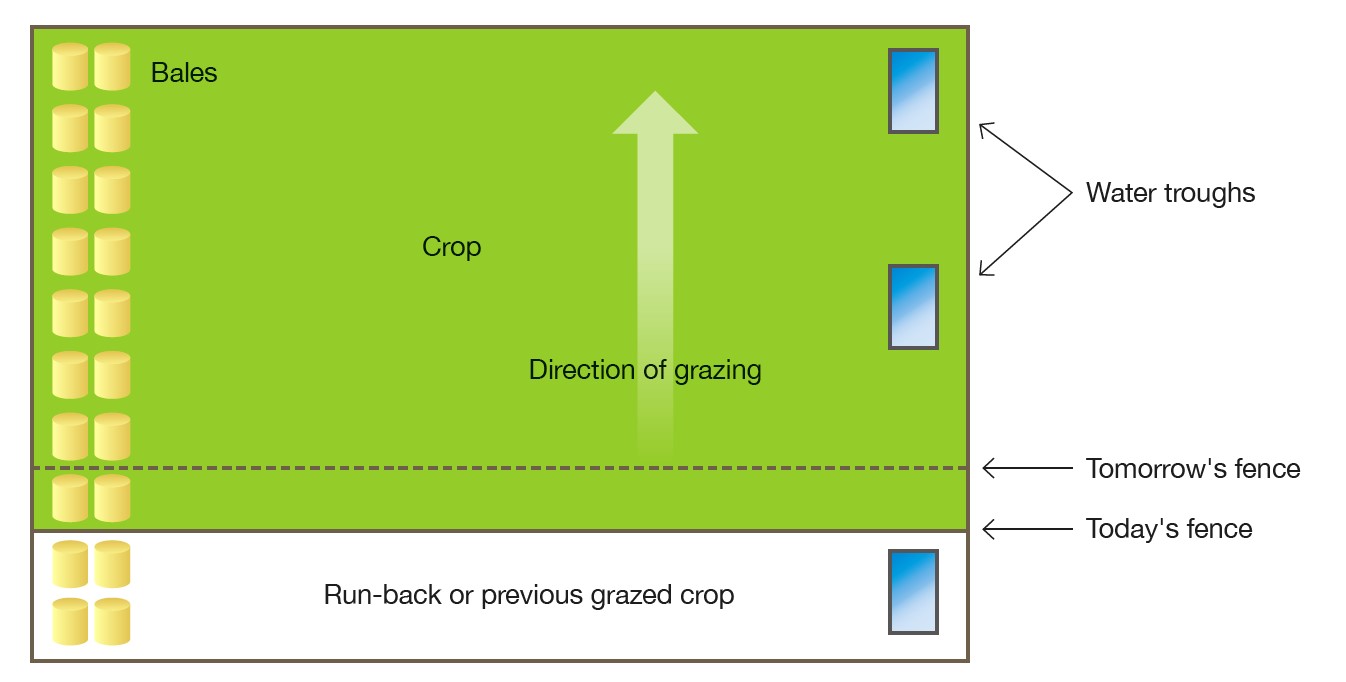- Home
- Knowledge library
- Feed planning for brassica and forage crops
Feed planning for brassica and forage crops
Brassica and forage crops require different management to grazed grass. See our tips on measuring DM and calculating daily feed requirements.
Back to: Grazed brassica and forage crops: feeding and management
Why is feed planning important?
Feed budgeting and planning can allow you to maximise the use of home-grown feeds and reduce the amount of bought-in feed. Assessing available feed also stops under or over allocation, which can improve efficiency and prevent waste.
When grazing brassica or forage crops, livestock must have access to hay, silage, or grass to promote saliva production and healthy rumen function. Straw is generally not recommended. Baled grass silage or hay should be 35% of total DM intake when feeding. Ensure this is accounted for in the feed budget so that all animals can access conserved forage.
Monitoring and reviewing your feed budget monthly will ensure nutrition and feed allowance is appropriate for livestock age, growth, ground conditions, shelter availability and stage of production. For example, heifers may require over 1 kg DM/animal/day additional allocation (or + 10–20% feed).
Some of our tools include:
AHDB grass and supplementation budget planner
Feed budget and rotation plan for cattle
How to measure forage crop yield
Measuring dry matter
For accurate feed planning, it is essential to measure the DM yield of the crop.
This can easily be done by using a:
- 1 m square frame
- Seedbag
- Garden shears
- Scales
Several samples should be taken from each field, picking representative sampling points. The process is:
- Place frame in the forage crop.
- Use shears to cut each plant within the frame (about 10 cm from the ground).
- Put the harvested crop in the bag.
- Hook bag onto scales.
- Record the crop weight per metre squared (kg/m2).
- Calculate DM yield/ha:
- Multiply the fresh weight per m2 by 10,000.
- Multiply by the expected crop DM percentage.
See our tables on cost and performance of livestock grazing brassica and forage crops.
For example: Kale from 1m2 = 5 kg fresh weight x 10,000 = 50,000 kg fresh weight/ha Average kale dry matter = 16% 50,000 x 0.16 = 8,000 kg (8 t) DM/ha
|
Row |
Description |
Example based on a 270 kg weanling requiring 8 kg DM/day |
Your livestock and forage requirements |
|
1 |
Livestock total daily intake (assume DM requirement of 3% of liveweight) |
8 kg DM/day |
|
|
2 |
Percentage of crop in the diet |
70% |
|
|
3 |
Crop daily requirement (row 1 multiplied by row 2, divided by 100) |
5.6 kg DM |
|
|
4 |
Number of livestock |
25 |
|
|
5 |
Daily crop requirement (row 3 multiplied by row 4) |
140 kg DM |
|
|
6 |
Estimated crop DM yield/m2* |
0.56 kg DM/m2 |
|
|
7 |
Total daily grazing area required (row 5 divided by row 6) |
250 m2 of brassica |
|
|
8 |
Length of feed face |
125 m |
|
|
9 |
Fence to be moved (row 7 divided by row 8) |
2 m/day |
|
Notes: *Based on crop yields of 8 t DM/ha (0.8 kg DM or 5 kg fresh weight per m2) multiplied by 70% utilisation.
Cost and performance of livestock grazing brassica and forage crops
Field design
A well-designed feed out system should help to reduce environmental impact and ease management. Things to consider:
- Grazing direction should be downhill so that any run-off gets captured by the standing crop
- Grazing duration and traffic should be managed using stocking density and moving troughs and feeders
- Provide maximum frontage (length) to the feed fence but a narrow strip of accessible feed, to allow all animals to feed at the same time (guidance is available at Red Tractor standards)
- Easily moveable electric feed fence will make management and crop allocation easier
- Place bales before winter to avoid driving over the crop and causing damage to the crop or soil
- Estimate supplementary feed requirements
- Infrastructure such as electric fencing, tracks, gateways, moveable water troughs and feeders
- Fence off watercourses and boggy areas to prevent damage and leaching
- Provide a well-drained, dry, accessible lying area with shelter to prevent animal heat loss
- Allow enough space for all animals to lie down at the same time, allocate 2 m2 per head for cattle
Example plan for establishing a feed face

Useful links
Use the feed and forage calculator
Using brassicas for Better Returns manual
Feeding suckler cows and calves
Feeding growing and finishing cattle
Making grass silage for better returns
If you would like to order a hard copy of the following resources, please contact publications@ahdb.org.uk or call 0247 799 0069:
- Using brassicas for Better Returns
- Feeding the ewe
- Feeding suckler cows and calves
- Feeding growing and finishing cattle
- Making grass silage for better returns
Topics:
Sectors:
Tags:

